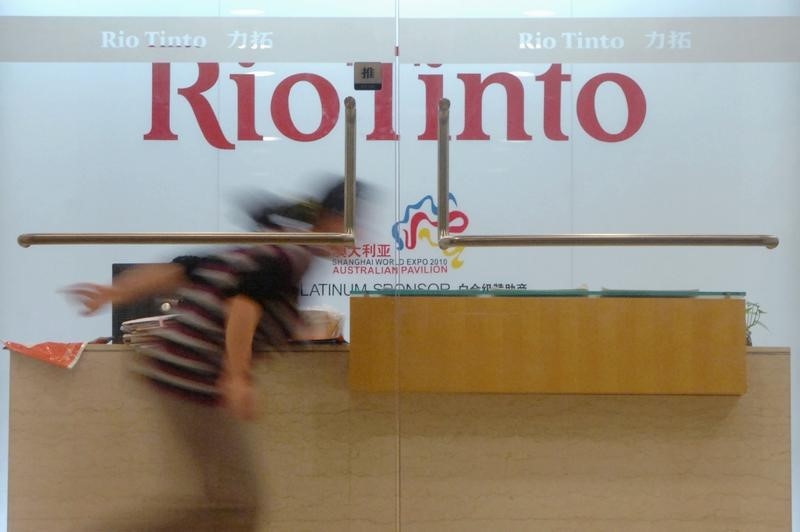(The opinions expressed here are those of the author, a columnist for Reuters.)
By Clyde Russell
LAUNCESTON, Australia, Feb 15 (Reuters) - - "We don't run our business on hope, we run it with foresight and focus." These are Rio Tinto (L:RIO) Chief Executive Sam Walsh's words, but he's only half right.
Walsh was speaking at a Feb. 11 briefing after Rio Tinto RIO.AX released its worst underlying earnings in 11 years, slumped to a net loss and ended its policy of increasing its dividend payments. no surprise that the ever-polite Walsh felt the need to engage in a bit of what may be termed fighting talk, as he tried to defend the scrapping of the progressive dividend policy amidst an increasingly bleak outlook for commodity prices and the global economy.
Where Walsh got it right is that Rio is run with ruthless focus, and Walsh and his executive team deserve credit for driving costs down to the point where a tonne of iron ore can be mined in Western Australia and delivered to an export harbour for around $15 a tonne.
This focus is helping the world's number two producer of the steel-making ingredient keep underlying earnings positive, even though the spot price of iron ore in Asia .IO62-CNI=SI was$43.20 a tonne on Feb. 12, barely one-fifth of what it fetched at its peak in 2011.
But where Walsh is on shaky ground is the idea that Rio Tinto has been run with great foresight.
The much-criticised forecast that China's steel output will rise to 1 billion tonnes a year by 2030 didn't seem to be mentioned in the post-results briefing.
Walsh did state that Rio has confidence in the longer-term iron ore outlook, but he spent considerably more time talking about the potential in developing nations in Asia and Africa than he did talking about China.
The simple truth is that Rio Tinto has been wrong on the Chinese steel market for some time and refuses to acknowledge this fact.
Chinese steel output peaked at about 823 million tonnes in 2014, and dropped to 803.8 million tonnes last year, according to official data.
Last year's output was also bolstered by the export of 112 million tonnes of steel product, a gain of almost 20 percent over 2014.
In other words, China is heading in the other direction to Rio Tinto's 1 billion tonne a year forecast, and there is little to suggest that the trend toward lower steel output and consumption is going to reverse.
China is trying to force unprofitable steel mills to close, and it's now likely that steel output this year will struggle to top 750 million tonnes, and may be closer to 700 million.
At the same time as the industry is trying to cut excess capacity, China's economic growth is slowing and changing in nature.
If Beijing is successful in creating a more consumer-driven economy, this will require less steel than the construction and infrastructure model of past years.
HOPELESSLY WRONG
For Rio's 1 billion forecast to come to pass, China would not only have to consume steel at the pace it did in the boom years, it would have to use 25 percent more than it did at its peak.
This seems increasingly unlikely, as China will probably be able to urbanise the millions of people it still needs to without requiring any more steel than it currently uses.
Consuming 700 million tonnes of steel annually would still deliver massive amounts of new housing, railways and other infrastructure.
Even if Rio's forecast does eventually prove true, it seems doomed to be wrong for the next few years.
The problem for Rio, along with its major rivals Vale VALE5.SA , BHP Billiton (L:BLT) BHP.AX and Fortescue Metals Group FMG.AX , is that they currently own and operate assets designed to supply a 1 billion tonne a year Chinese steel market.
Rio's planned iron ore capacity is 360 million tonnes, BHP's is 250 million, Fortescue is about 160 million and Vale aims to produce about 350 million this year, although it has plans to eventually produce more than 400 million a year.
This means that together the big four iron ore miners can supply about 1.1 billion tonnes a year, or about 200 million tonnes more than China imported in 2015.
They have got to this point by being very focused on maximising output and minimising costs. However, given the close correlation between Rio's share price and spot iron ore, it's clear something more has to be done to rescue both.
But what foresight should Rio and the other iron ore producers be employing currently?
The first step is to acknowledge they were wrong, in fact hopelessly wrong on China.
The second is to decide whether its better to continue to over-produce and keep prices in the doldrums for years, with the eventual aim of driving smaller competitors out of business.
Evidence from coal and crude oil suggest that this will be a long and painful process.
Or is it time to find another way to deliver value to shareholders?
This may become more pressing as it's likely that the limits of cost-cutting will be reached sooner rather than later, especially if oil prices start to recover given the extensive use of diesel and fuel oil in the mining and transportation of iron ore.
The 1 billion tonnes of steel a year China forecast is starting to become an albatross around the company's neck. <^^^^^^^^^^^^^^^^^^^^^^^^^^^^^^^^^^^^^^^^^^^^^^^^^^^^^^^^^
Graphic of spot iron ore vs. Rio share price:
http://tmsnrt.rs/1OaPTh8 ^^^^^^^^^^^^^^^^^^^^^^^^^^^^^^^^^^^^^^^^^^^^^^^^^^^^^^^^^>
(Editing by Richard Pullin)
